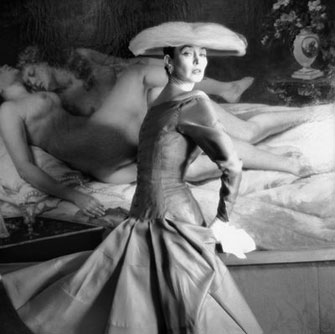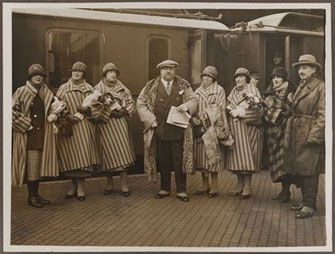Models: The People
Behind the Puppets

Model Dorian Leigh photographed by Henry Clarke in 1955. © Henry Clarke/Galliera
In these advert-saturated times, it can be easy to tire of fashion photography, with its dour models and outlandish outfits. Paris in particular is crowded with billboards, Métro posters and magazines doggedly flogging fantasies to a thirsty public – so much so that the prospect of an entire exhibition dedicated to the fashion industry’s carrier pigeon – the model – might not appeal to all. Yet “Mannequin: Le Corps de la Mode,” at Les Docks-Cité de la Mode et du Design, proves that there is a lot more to models and the history of their profession than meets the eye.
The show charts the development of the figure of the model from the earliest moments of her genesis in the sepia days of the 19th century to the present. Refreshingly, visitors are not guided through the past in chronological order, but presented with photographs and artifacts that follow a coherent thematic scheme, starting with a section dedicated to three-dimensional mannequins. Helmut Newton’s images showing models interacting with their plastic doppelgangers as if they were alive are especially striking, pointing gently and disturbingly to the extent to which the fashion industry is willing to erode personality and difference if it will induce customers to reach for their wallets.
This darkly fascinating opening sets the tone for the rest of the show, which returns repeatedly to the central evocation of the model as the puppet of fashion authorities holding the strings. Gregoire Alexander’s photograph “Shopping” is particularly disquieting, revealing a snake of bikini-clad young women at a casting call, proceeding around a white room like show-calves at a cattle fair. These females look nothing like the empowered, glamorous idols consumers are used to seeing in magazines, a disparity partly elucidated by an interesting demonstration on a computer screen of how photographs can be photo-shopped to make their subjects look fatter, thinner or more generously endowed.
Mercifully, it’s not all doom and gloom, for peppering these sinister images of exploitation and mistreatment are generous sprinklings of fashion fun – vintage magazine covers harking back to a time of greater elegance and simplicity, a wooden bodice whose waist is so minute that one is forced to wonder where the wearer’s organs were displaced to, videos of 1980s catwalks pumped up with inventiveness and swagger. Perhaps the most amusing image 
Fashion designer Paul Poiret with his models in 1925. Anonymous. © Galliera/Roger-Violletoffered up is that of the couturier Paul Poiret, dapper among an entourage of six models identically dressed in striped coats and tight hats, and referred to by Poiret as “ma propagande.”
Yet for all the pomp and pomposity of images such as these, the exhibition’s closing melody is firmly transposed to the minor key by a series of photographs showing young women offering themselves up to agencies looking for the next Moss, the next Campbell, the next Delevigne. Most have barely left infancy; they look as if they are short of money, protection and even, in some cases, good looks. It is a moving and unexpected finale to an exhibition that roundly demonstrates that the model is, in fact, a far-from exhausted topic, and that the individuals that compose its ever-mutating face are less glamorous, less immaculate and more vulnerable than popular culture would have us believe.
Les Docks-Cité de la Mode et du Design: 34, quai d’Austerlitz, 75013 Paris. Métro: Gare d’Austerlitz. Tel.: 01 76 77 25 30. Open Tuesday-Sunday, 10am-6pm. Closed Mondays and public holidays. Admission: €6. Through May 19. www.paris-docks-en-seine.fr
Reader Susan Stamberg writes: “This is a wonderfully written and carefully reported story, full of insights readers can apply when we spot our next poster or fashion magazine. Thank you!”
Reader reaction: Click here to respond to this article (your response may be published on this page and is subject to editing).
Please support Paris Update by ordering books from Paris Update’s Amazon store at no extra cost. Click on your preferred Amazon location: U.K., France, U.S.
More reviews of Paris art shows.
© 2013 Paris Update
Favorite